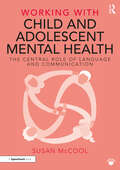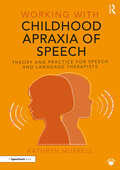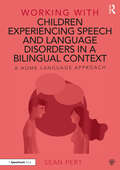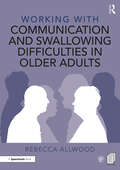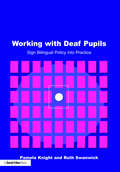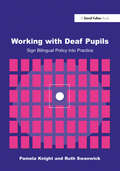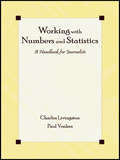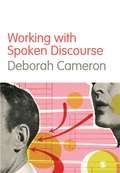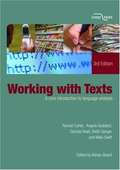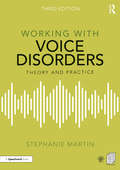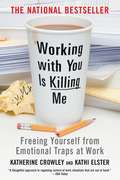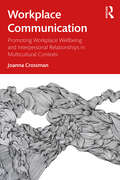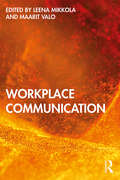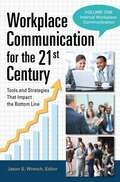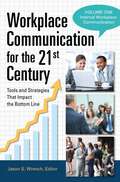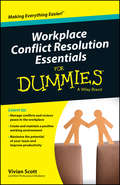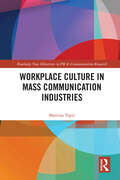- Table View
- List View
Working with Child and Adolescent Mental Health: The Central Role of Language and Communication (Working With)
by Susan McCoolIn children, mental health challenges and communication differences typically combine in complex and inter-related ways. Remarkably, this crucial point is all too often forgotten, and communication is overlooked. Services are frequently fragmented, leading professionals to look at children through distinct lenses of either mental health or communication, meaning insights can be incomplete and important perspectives unshared. Working with Child and Adolescent Mental Health makes the compelling case that communication is central and should be a primary consideration whenever we think about children’s mental health. With a practical focus, and an easy- to-read format, it suggests how this can be achieved by identifying how practitioners and services can work more cohesively to understand and optimise children’s communication capacities. This book includes: Practical advice, grounded in current research, and presented in an easy-to-read, digestible style Guidance to help practitioners competently and compassionately identify and respond to the needs of children and young people with complex combined communication and mental health needs Real-life case studies from a wide range of settings, unpicked to clearly illustrate topics discussed in the book and offer encouragement and inspiration to practitioners Checklists and questionnaires to help practitioners in daily practice Recommendations for, and links to, useful additional resources Tools to support reflection and enhancement for individual practitioners and services Essential reading for speech and language therapists, psychologists, mental health practitioners, educators, social workers, and anyone else concerned with children’s wellbeing and resilience, this book highlights the transformational impact of placing communication at the heart of all efforts to support children and young people’s mental health.
Working with Childhood Apraxia of Speech: Theory and Practice for Speech and Language Therapists (Working With)
by Kathryn MurrellThis resource will lead the reader through the practicalities of assessment, diagnosis, and therapeutic intervention for children of all ages with features of childhood apraxia of speech. It provides the theory and underlying principles upon which to work with children who have this fascinating but challenging disorder in collaboration with families and schools.Chapters are clearly laid out, with hands on activities for intervention and helpful summaries. There is a focus on alternative and augmentative means of communication and multidisciplinary working, as well as a wealth of case studies and teaching notes for training other professionals. Fresh ways of working are addressed, such as the use of teletherapy and other techniques such as group therapy and the consultative approach are discussed.Key features include: A theoretical overview of current thinking about childhood apraxia of speech A structured assessment format with a chapter specifically focused on how to take a detailed speech sample Clear guidance on how to make a differential diagnosis How to spot early indicators of childhood apraxia of speech Advice sheets for parents and schools Downloadable record forms for case history taking and assessment. This book can be read cover to cover or dipped into for quick and easy therapy ideas and is presented in an easy-to-read format, with chapters broken down into bite-sized chunks. It is an essential handbook for all speech and language therapists and students, whatever their level of experience.
Working with Childhood Apraxia of Speech: Theory and Practice for Speech and Language Therapists (Working With)
by Kathryn MurrellThis resource will lead the reader through the practicalities of assessment, diagnosis, and therapeutic intervention for children of all ages with features of childhood apraxia of speech. It provides the theory and underlying principles upon which to work with children who have this fascinating but challenging disorder in collaboration with families and schools.Chapters are clearly laid out, with hands on activities for intervention and helpful summaries. There is a focus on alternative and augmentative means of communication and multidisciplinary working, as well as a wealth of case studies and teaching notes for training other professionals. Fresh ways of working are addressed, such as the use of teletherapy and other techniques such as group therapy and the consultative approach are discussed.Key features include: A theoretical overview of current thinking about childhood apraxia of speech A structured assessment format with a chapter specifically focused on how to take a detailed speech sample Clear guidance on how to make a differential diagnosis How to spot early indicators of childhood apraxia of speech Advice sheets for parents and schools Downloadable record forms for case history taking and assessment. This book can be read cover to cover or dipped into for quick and easy therapy ideas and is presented in an easy-to-read format, with chapters broken down into bite-sized chunks. It is an essential handbook for all speech and language therapists and students, whatever their level of experience.
Working with Children Experiencing Speech and Language Disorders in a Bilingual Context: A Home Language Approach (Working With)
by Sean PertThe complexity of speech and language disorders can be daunting in a monolingual context. When working with a bilingual child assessment and intervention may appear to be even more complicated. In this book Sean Pert provides the reader with the tools needed to overcome this perception and develop skills in working in a language that they don’t share with the client. By adopting a home language first approach the book discusses how to: identify diversity from disorder introduce effective approaches in line with the best clinical practice work successfully alongside interpreters make assessments and plan interventions set goals for therapy. At the heart of the text is the therapist creating essential partnerships with parents and truly valuing the bilingualism, culture and identity of the child. This leads to better outcomes, not only in speech, language and communication, but also in self-esteem, mental health, social participation and educational and employment success. The book concludes with a handy toolkit of resources including quizzes, case studies and printable extras making it the perfect resource for both experienced and newly qualified practitioners with bilingual and multilingual children in their care.
Working with Children Experiencing Speech and Language Disorders in a Bilingual Context: A Home Language Approach (Working With)
by Sean PertThe complexity of speech and language disorders can be daunting in a monolingual context. When working with a bilingual child assessment and intervention may appear to be even more complicated. In this book Sean Pert provides the reader with the tools needed to overcome this perception and develop skills in working in a language that they don’t share with the client. By adopting a home language first approach the book discusses how to: identify diversity from disorder introduce effective approaches in line with the best clinical practice work successfully alongside interpreters make assessments and plan interventions set goals for therapy. At the heart of the text is the therapist creating essential partnerships with parents and truly valuing the bilingualism, culture and identity of the child. This leads to better outcomes, not only in speech, language and communication, but also in self-esteem, mental health, social participation and educational and employment success. The book concludes with a handy toolkit of resources including quizzes, case studies and printable extras making it the perfect resource for both experienced and newly qualified practitioners with bilingual and multilingual children in their care.
Working with Communication and Swallowing Difficulties in Older Adults (Working With)
by Rebecca AllwoodThis accessible resource offers valuable guidance for all student and practising speech and language therapists (SLTs)who are working with older people with communication and swallowing difficulties. Chapters provide up-to-date theory on age-related changes alongside practical strategies for clinicians to use in their daily work, from help with mental capacity decisions to supporting older people with good palliative care. Promoting a holistic approach for ageing well, this resource dispels myths that surround the ageing process while detailing the normal physiological and psychological effects of ageing on communication and swallowing, as well as diseases and conditions associated with older age, such as frailty. Illustrated throughout with clinical case studies and helpful photocopiable resources to use in practice, this book is a key part of the tool kit for any speech and language therapist working with older adults.
Working with Communication and Swallowing Difficulties in Older Adults (Working With)
by Rebecca AllwoodThis accessible resource offers valuable guidance for all student and practising speech and language therapists (SLTs)who are working with older people with communication and swallowing difficulties. Chapters provide up-to-date theory on age-related changes alongside practical strategies for clinicians to use in their daily work, from help with mental capacity decisions to supporting older people with good palliative care. Promoting a holistic approach for ageing well, this resource dispels myths that surround the ageing process while detailing the normal physiological and psychological effects of ageing on communication and swallowing, as well as diseases and conditions associated with older age, such as frailty. Illustrated throughout with clinical case studies and helpful photocopiable resources to use in practice, this book is a key part of the tool kit for any speech and language therapist working with older adults.
Working with Deaf Children: Sign Bilingual Policy into Practice
by Pamela Knight Ruth SwanwickThis book is essential and accessible reading for all teachers and professionals who are working with sign bilingual deaf children. It considers the background and theory underpinning current developments in sign bilingual education and the implications for policy and developing classroom practice. Practical teaching strategies are suggested and evaluated. The authors draw on their own experience of working in sign bilingual settings as well as current good practice and relevant research. This book is the first UK book that describes sign bilingual education (beyond policy). It is also the first book to support sign bilingual practice dealing with current educational issues. The authors draw together relevant research and practice in sign bilingual education and present practical strategies for teachers.
Working with Deaf Children: Sign Bilingual Policy into Practice
by Pamela Knight Ruth SwanwickThis book is essential and accessible reading for all teachers and professionals who are working with sign bilingual deaf children. It considers the background and theory underpinning current developments in sign bilingual education and the implications for policy and developing classroom practice. Practical teaching strategies are suggested and evaluated. The authors draw on their own experience of working in sign bilingual settings as well as current good practice and relevant research. This book is the first UK book that describes sign bilingual education (beyond policy). It is also the first book to support sign bilingual practice dealing with current educational issues. The authors draw together relevant research and practice in sign bilingual education and present practical strategies for teachers.
Working With Numbers and Statistics: A Handbook for Journalists
by Charles Livingston Paul S. VoakesWorking With Numbers and Statistics: A Handbook for Journalists will bolster math skills and improve math confidence for journalists at all skill levels. Authors Charles Livingston and Paul Voakes developed this resource book to improve journalistic writing and reporting, enabling journalists to:*make accurate, reliable computations, which in turn enables one to make relevant comparisons, put facts into perspective, and lend important context to stories;*recognize inaccurate presentations, whether willfully spun or just carelessly relayed;*ask appropriate questions about numerical matters;*translate complicated numbers for viewers and readers in ways they can readily understand;*understand computer-assisted reporting; and*write livelier, more precise pieces through the use of numbers.The math is presented in a journalistic context throughout, enabling readers to see how the procedures will come into play in their work.Working With Numbers and Statistics is designed as a reference work for journalism students developing their writing and reporting skills. It will also serve professionals as a useful tool to improve their understanding and use of numbers in news stories.
Working With Numbers and Statistics: A Handbook for Journalists
by Charles Livingston Paul S. VoakesWorking With Numbers and Statistics: A Handbook for Journalists will bolster math skills and improve math confidence for journalists at all skill levels. Authors Charles Livingston and Paul Voakes developed this resource book to improve journalistic writing and reporting, enabling journalists to:*make accurate, reliable computations, which in turn enables one to make relevant comparisons, put facts into perspective, and lend important context to stories;*recognize inaccurate presentations, whether willfully spun or just carelessly relayed;*ask appropriate questions about numerical matters;*translate complicated numbers for viewers and readers in ways they can readily understand;*understand computer-assisted reporting; and*write livelier, more precise pieces through the use of numbers.The math is presented in a journalistic context throughout, enabling readers to see how the procedures will come into play in their work.Working With Numbers and Statistics is designed as a reference work for journalism students developing their writing and reporting skills. It will also serve professionals as a useful tool to improve their understanding and use of numbers in news stories.
Working with Spoken Discourse (1st edition)
by Deborah Cameron"An exemplary textbook. Making even the most complex ideas fully accessible, it is grounded in an extensive literature, filled with engaging examples, and offers ample suggestions for independent research. It's been a key text in my classes for over a decade and, as fresh and relevant as ever, will continue to buttress my graduate seminars and undergraduate courses alike. " - Professor Crispin Thurlow, University of Washington Comprehensive, practical, lively and accessible, Working with Spoken Discourse is the much-loved benchmark for learning to do discourse analysis. It combines theory and practice to give students the grounding they need in practical techniques of analyzing talk and how to apply them to real data. Begins with the 'why' and 'how' of doing discourse analysis Packs examples into every chapter to help explain complex concepts Uses exercises and activities to reinforce what you've learned Leads you through the practicalities of designing your own project Exceptionally clear, and perfect for undergraduates starting a project, this is the essential guide to spoken discourse.
Working With Texts: A Core Introduction To Language Analysis (PDF)
by Maggie Bowring Danuta Reah Keith Sanger Adrian Beard Angela Goddard Nikki Swift Ronald CarterWorking with Textsis a well established textbook that introduces students to the main principles of language analysis, through contemporary text examples. Covering a wide range of language areas, the book uses an interactive, activity-based approach to support students' understanding of language structure and variety. The third edition includes: new material on analyzing sound; an updated range of texts, including literary extracts, advertisements, newspaper articles, comic book strips, excerpts from popular comedy sketches, political speeches, telephone discourse, and internet chat; new extension work to support student-directed study; detailed suggestions after each unit for further reading within the Intertextseries as a whole; and an updated list of URLs. ISBN10: 0415414210 (hbk) ISBN10: 0415414245 (pbk) ISBN13: 9780415414210 (hbk) ISBN13: 9780415414241 (pbk)
Working with Voice Disorders: Theory and Practice (Working With)
by Stephanie MartinNow in a fully revised and updated third edition, Working with Voice Disorders offers practical insight and direction into all aspects of voice disorders, from assessment and diagnosis to intervention and case management. Using evidence-based material, it provides clinicians with pragmatic, accessible support, facilitating and informing decision-making along the clinical journey, from referral to discharge. Key features of this resource include: A wealth of new, up-to-date practical and theoretical information, covering topics such as the prevention, assessment, intervention and treatment of a wide spectrum of voice disorders. A multi-dimensional structure, allowing the clinician to consider both specific aspects of patient management and aspects such as clinical effectiveness, clinical efficiencies and service management. Photocopiable clinical resources, from an at-a-glance summary of voice disorders to treatment and assessment protocols, and practical exercises and advice sheets for patients. Sample programmes for voice information groups and teacher workshops. Checklists for patients on topics such as the environmental and acoustic challenges of the workplace. Self-assessed personalised voice review sheets and weekly voice diaries encourage patients to monitor their voice quality and utilise strategies to prevent vocal misuse. Combining the successful format of mixing theory and practice, this edition offers a patient-centred approach to voice disorders in a fully accessible and easy-to-read format and addresses the challenges of service provision in a changing world. This is an essential resource for speech and language therapists of varying levels of experience, from student to specialist.
Working with Voice Disorders: Theory and Practice (Working With)
by Stephanie MartinNow in a fully revised and updated third edition, Working with Voice Disorders offers practical insight and direction into all aspects of voice disorders, from assessment and diagnosis to intervention and case management. Using evidence-based material, it provides clinicians with pragmatic, accessible support, facilitating and informing decision-making along the clinical journey, from referral to discharge. Key features of this resource include: A wealth of new, up-to-date practical and theoretical information, covering topics such as the prevention, assessment, intervention and treatment of a wide spectrum of voice disorders. A multi-dimensional structure, allowing the clinician to consider both specific aspects of patient management and aspects such as clinical effectiveness, clinical efficiencies and service management. Photocopiable clinical resources, from an at-a-glance summary of voice disorders to treatment and assessment protocols, and practical exercises and advice sheets for patients. Sample programmes for voice information groups and teacher workshops. Checklists for patients on topics such as the environmental and acoustic challenges of the workplace. Self-assessed personalised voice review sheets and weekly voice diaries encourage patients to monitor their voice quality and utilise strategies to prevent vocal misuse. Combining the successful format of mixing theory and practice, this edition offers a patient-centred approach to voice disorders in a fully accessible and easy-to-read format and addresses the challenges of service provision in a changing world. This is an essential resource for speech and language therapists of varying levels of experience, from student to specialist.
Working With You is Killing Me: Freeing Yourself from Emotional Traps at Work
by Katherine Crowley Kathi ElsterTwo well-respected management experts deliver an authoritative manual that provides valuable insights for turning conflicts in the workplace into productive working relationships.The toughest part of any job is dealing with the people around you. Scratch the surface of any company and uncover a hotbed of emotions—people feeling anxious about performance, angry at co-workers, and misunderstood by management. Now, in WORKING WITH YOU IS KILLING ME, readers learn how to &“unhook&” from these emotional pitfalls and gain valuable strategies for confronting workplace conflicts in a healthy, productive way. They&’ll discover how to: Manage an ill-tempered boss before he or she explodesDefend themselves against idea-pilfering rivals before they steal all the creditDetach from those annoying co-workers whose irritating habits ruin the dayAnd much, much more.
Workplace Communication: Promoting Workplace Wellbeing and Interpersonal Relationships in Multicultural Contexts
by Joanna CrossmanWorkplace Communication highlights how we can build interpersonal relationships through effective communication and why this is essential to workplace wellbeing. Well-supported by contemporary, reputable empirical studies, the book also comes with exercises and open-ended questions based on the subject matter. The book provides a comprehensive overview on creating an inclusive workplace and managing workplace diversity; covers a wide range of salient, up-to-date reputable literature on a wide range of management and business topics; contains practical, ‘road-tested’ activities to promote student reflection, experiential learning, critical thinking, research skills, and application of theory to practice and vice versa; examines how we communicate effectively to an increasingly diverse workforce. Designed for a broad audience, this book will appeal to academics and students in the fields of business management and communications. It will also be a useful reference for organisational practitioners and leaders.
Workplace Communication: Promoting Workplace Wellbeing and Interpersonal Relationships in Multicultural Contexts
by Joanna CrossmanWorkplace Communication highlights how we can build interpersonal relationships through effective communication and why this is essential to workplace wellbeing. Well-supported by contemporary, reputable empirical studies, the book also comes with exercises and open-ended questions based on the subject matter. The book provides a comprehensive overview on creating an inclusive workplace and managing workplace diversity; covers a wide range of salient, up-to-date reputable literature on a wide range of management and business topics; contains practical, ‘road-tested’ activities to promote student reflection, experiential learning, critical thinking, research skills, and application of theory to practice and vice versa; examines how we communicate effectively to an increasingly diverse workforce. Designed for a broad audience, this book will appeal to academics and students in the fields of business management and communications. It will also be a useful reference for organisational practitioners and leaders.
Workplace Communication
by Leena Mikkola Maarit ValoThis book provides insights into communication practices that enable efficient work, successful collaboration, and a functional work environment. Maintaining a productive and healthy workplace is predicated on interpersonal communication between people. In organizations, efficient communication is the foundation of all actions. Contributors to this book cover communication issues in relationships, teams, meetings, leadership, competence, diversity, organizational entry, social support, and digital environments in the workplace. The book illustrates all these issues in detail by presenting both relevant research findings and their practical implications in working life. Workplace Communication is ideal for current and future employees, directors, supervisors and managers, instructors, and consultants in knowledge-based expertise work. The book is appropriate for courses in organizational and leadership communication or interpersonal communication in a workplace setting.
Workplace Communication
by Leena Mikkola Maarit ValoThis book provides insights into communication practices that enable efficient work, successful collaboration, and a functional work environment. Maintaining a productive and healthy workplace is predicated on interpersonal communication between people. In organizations, efficient communication is the foundation of all actions. Contributors to this book cover communication issues in relationships, teams, meetings, leadership, competence, diversity, organizational entry, social support, and digital environments in the workplace. The book illustrates all these issues in detail by presenting both relevant research findings and their practical implications in working life. Workplace Communication is ideal for current and future employees, directors, supervisors and managers, instructors, and consultants in knowledge-based expertise work. The book is appropriate for courses in organizational and leadership communication or interpersonal communication in a workplace setting.
Workplace Communication for the 21st Century [2 volumes]: Tools and Strategies That Impact the Bottom Line [2 volumes]
by Jason S. WrenchWritten in clear, non-technical language, this book explains how employees and employers can maximize internal and external organizational communication—for both personal benefit and to the entity as a whole.Workplace Communication for the 21st Century: Tools and Strategies That Impact the Bottom Line explains and simplifies what organizational communication scholars have learned, presenting this knowledge so that it can be easily applied to generate tangible benefits to employees and employers as they face everyday challenges in the real world.This two-volume work discusses internal organizational and external organizational communication separately, first explaining how communication functions within the confines of a modern organization, then addressing how organizations interact with various stakeholders, such as customers, clients, and regulatory agencies. The expert contributors provide a thorough and insightful view on organizational communication and supply a range of strategies that will be useful to practitioners and academics alike.
Workplace Communication for the 21st Century [2 volumes]: Tools and Strategies That Impact the Bottom Line [2 volumes]
by Jason S. WrenchWritten in clear, non-technical language, this book explains how employees and employers can maximize internal and external organizational communication—for both personal benefit and to the entity as a whole.Workplace Communication for the 21st Century: Tools and Strategies That Impact the Bottom Line explains and simplifies what organizational communication scholars have learned, presenting this knowledge so that it can be easily applied to generate tangible benefits to employees and employers as they face everyday challenges in the real world.This two-volume work discusses internal organizational and external organizational communication separately, first explaining how communication functions within the confines of a modern organization, then addressing how organizations interact with various stakeholders, such as customers, clients, and regulatory agencies. The expert contributors provide a thorough and insightful view on organizational communication and supply a range of strategies that will be useful to practitioners and academics alike.
Workplace Conflict Resolution Essentials For Dummies (For Dummies)
by Vivian ScottResolving conflict in the workplace? No problem! Working your way through a conflict in the office can present unexpected challenges, but there's no need to feel unprepared — Workplace Conflict Resolution Essentials For Dummies has you covered! In the book, you'll find practical, expert guidance on various approaches to negotiating and mediating a successful resolution for you and your team. You'll get coverage of negotiation techniques, mediation methods and solutions for managers and employees dealing with workplace conflict, and tons of tips on building and maintaining successful teams to work through existing conflicts and help avoid future disturbances. Encouraging colleagues to work together toward a common goal is an essential skill that all successful business professionals must possess. Rather than resorting to arguments, surrendering, running away or filing a complaint, this resource shows you how to address uncomfortable conflict in the workplace head-on, giving you the tools and advice you need to restore peace, prevent conflicts from ever starting in the first place, and maintain better productivity while boosting morale. Offers clear instruction for addressing conflicts, resolving disputes and restoring peace and productivity to the workplace Helps you find a solution and explore positive means for resolving conflicts Illustrates how working through problems within your team makes the workplace the positive environment it should be Provides guidance on developing the key negotiation and mediation skills you need to create a harmonious workplace Whether you're new to managing professionals, working your way up the corporate ladder or just want to brush up on your knowledge base, Workplace Conflict Resolution Essentials For Dummies has everything you need to ensure your workplace environment is positive and productive!
Workplace Conflict Resolution Essentials For Dummies
by Vivian ScottResolving conflict in the workplace? No problem! Working your way through a conflict in the office can present unexpected challenges, but there's no need to feel unprepared — Workplace Conflict Resolution Essentials For Dummies has you covered! In the book, you'll find practical, expert guidance on various approaches to negotiating and mediating a successful resolution for you and your team. You'll get coverage of negotiation techniques, mediation methods and solutions for managers and employees dealing with workplace conflict, and tons of tips on building and maintaining successful teams to work through existing conflicts and help avoid future disturbances. Encouraging colleagues to work together toward a common goal is an essential skill that all successful business professionals must possess. Rather than resorting to arguments, surrendering, running away or filing a complaint, this resource shows you how to address uncomfortable conflict in the workplace head-on, giving you the tools and advice you need to restore peace, prevent conflicts from ever starting in the first place, and maintain better productivity while boosting morale. Offers clear instruction for addressing conflicts, resolving disputes and restoring peace and productivity to the workplace Helps you find a solution and explore positive means for resolving conflicts Illustrates how working through problems within your team makes the workplace the positive environment it should be Provides guidance on developing the key negotiation and mediation skills you need to create a harmonious workplace Whether you're new to managing professionals, working your way up the corporate ladder or just want to brush up on your knowledge base, Workplace Conflict Resolution Essentials For Dummies has everything you need to ensure your workplace environment is positive and productive!
Workplace Culture in Mass Communication Industries (Routledge New Directions in PR & Communication Research)
by Martina TopićAcross communication industries, women face barriers and a catch 22 at all organisational levels and suffer from cultural masculinities. Offering a systematic overview of women’s lived experiences, this book discusses major issues in contemporary communication industries, including public relations, journalism and advertising, to understand the barriers that still exist. With a particular focus on office culture, the book concentrates on analysing the position and experiences of women working across communication industries and uses the theoretical framework of cultural masculinities to explore whether women’s organisational experiences and the lack of opportunities span across sectors. The author explores how cultural masculinities as well as discrimination, sexism and harassment can work against women’s interests and impede their career progression. The chapters provide a quality overview of existing theories as well as new insights to demonstrate how organisations operate and function in a way that systematically disadvantages women. The book will be a valuable resource for academics and researchers in the fields of organisational studies, public relations, advertising and journalism, as well as postgraduate and doctoral students in these areas. The interdisciplinary nature will also appeal to those across gender and labour studies, and human resource management.
